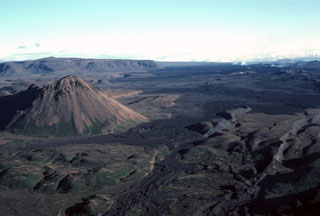Report on Krafla (Iceland) — October 1980
Scientific Event Alert Network Bulletin, vol. 5, no. 10 (October 1980)
Managing Editor: David Squires.
Krafla (Iceland) Fissure eruption
Please cite this report as:
Global Volcanism Program, 1980. Report on Krafla (Iceland) (Squires, D., ed.). Scientific Event Alert Network Bulletin, 5:10. Smithsonian Institution. https://doi.org/10.5479/si.GVP.SEAN198010-373080
Krafla
Iceland
65.715°N, 16.728°W; summit elev. 800 m
All times are local (unless otherwise noted)
"Inflation of the magma chambers, as monitored by crustal movement, continued after the eruption of 10-18 July. The previous ground levels were reached about the middle of October when two very minor deflations took place. Early in the morning of 18 October, continuously recording tiltmeters close to the crater row (~600 m) showed rapid inflation while tiltmeters farther away showed no unusual behavior.
"At about 1842 the three tiltmeters close to the magma reservoirs suddenly started to show very rapid deflation and continuous tremor started on the seismometers at 1847.
"At 2203 a fissure eruption started about 1 km N of Leirhnjúkur, near the center of Krafla caldera. The eruptive fissure quickly extended N about 6 km and S towards Leirhnjúkur. The eruptive fissures were discontinuous and extended over a 7 km-long segment of the fissure system. In the early morning of 19 October activity decreased in the S part of the fissure system and finally concentrated on a 200-300-m-long segment near the northernmost original fissure.
"Activity decreased gradually after that until between 1500 and 1600 on 23 October when lava production ceased somewhat abruptly. Some activity remained in the craters until about midnight. During the eruption tiltmeters near the magma reservoirs showed little movement but almost simultaneously with the ceasing of the lava production rapid inflation started again.
"The new lava covers an area of 11-12 km2. The absolute amount of subsidence is not known yet but the amount of tilt recorded by the tiltmeters is only about half of that accompanying the July eruption. This indicates that again the bulk of the magma drained from the magma reservoirs reached the surface. The relatively small deflation and present high inflation rate suggest that previous ground levels could be reached during November or early December, with at least similar probability of a renewed eruption.
"The beginning of the eruption was witnessed by a few observers. The eruption site was closer to the populated area and the Krafla power plant than in previous eruptions and the population had been warned before the eruption started. But with the activity concentrating in the N the hazard quickly ceased."
Geological Summary. The Krafla volcanic system in the Northern Volcanic Zone (NVZ) of Iceland is about 100 km long, consisting of a fissure swarm and a central volcano with a 7 x 9 km caldera formed about 110,000 years ago that deposited a rhyolitic welded tuff. It has been moderately active in the Holocene, over three distinct eruptive periods; the current one has lasted about 2,800 years with six volcano-tectonic episodes, each with one or more basaltic fissure eruptions. Lava volumes (DRE) have been in the 0.1-1 km3 range. The Hverfjall and Ludent tuff rings east of Myvatn were erupted along the fissure system. Myvatn lake formed during the eruption of the older Laxarhraun lava flow from the Ketildyngja shield volcano of the Fremrinamur volcanic system about 3,800 years before present (BP); The present Myvatn lake is constrained by the roughly 2,000 years BP younger Laxarhraun lava flow from the Krafla volcanic system. The abundant pseudocraters that form a prominent part of the Myvatn landscape were created when the younger Laxarhraun lava flow entered the lake. The last eruption took place in 1975-1984 CE when nine small basaltic fissure eruptions produced 0.25 km3 of lava.
Information Contacts: K. Grönvold, NVI.

